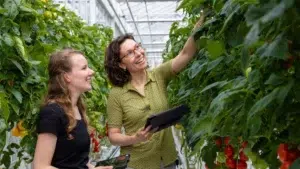In plant breeding, molecular techniques are used to screen thousands of lines before they even get to the glasshouse or field. This can remove breeding lines that do not express specific breeding aims, such as disease resistance, without having grown them. This advance in breeding techniques has allowed faster and more targeted variety improvement.
This efficiency has resulted in a larger number of varieties being submitted for DUS (Distinctness, Uniformity and Stability) testing for PBR (Plant Breeder’s Rights) and/or National Listing in the case of agricultural crops. The DUS system must adapt to be able to cope with this increase effectively whilst maintaining the standards already in place.
What are the DUS issues?
One of the most significant difficulties with the DUS testing system is the increasing size of the reference collections. Relevant new varieties granted PBR or added to a National List are added to the reference collection for the trial(s), which follow. Testing Authorities have developed various approaches to this situation, e.g. cyclic planting in out-breeding crops or database management, for screening self-pollinating and clonally propagated crops. However, with increasing collections, the systems in place are themselves becoming difficult to manage. This is a particular problem in crops where the parental lines of hybrids are also evaluated within the DUS test, for each and every hybrid variety there can be between three and five parental lines added to the test. The increasing size of the DUS reference collection is resulting in a testing system that is becoming unsustainable.
The question of maintaining a reference collection is also raised in truly international crops, where the same varieties are sold worldwide. The difficulties arise when transferring plant material from one country to another while maintaining phytosanitary standards. Also, the logistics of moving live plant material can be troublesome, there is no guarantee that the samples will arrive in a condition ready for trial.
Another issue in the compilation of a reference collection is locating plant material on the open market that is of an appropriate growth stage; again, this is a particular problem in ornamental crops. Using plant material from a range of sources means that the effect of initial growing conditions on the morphology of the plants must be considered. For example, tissue culture production or simply the age of the material can affect certain characteristics, not to mention the extreme effect the use of plant growth regulators (PGRs), which is not permitted, but can happen, or day length treatments can have. The result of this could be that characteristics have to be assessed with caution or that the trial has to be extended to allow natural expression to be observed.
Are there molecular solutions?
To help manage reference collections and ensure effective comparisons, molecular techniques could be used as a tool to screen varieties before the growing trial has started. Practical examples of identifying the most similar varieties using molecular techniques are being developed for some crops within the DUS testing system ensuring that existing standards that dictate whether a variety is considered ‘clearly distinct’ are not eroded. In these cases, it is expected that a candidate variety is grown alongside the most similar varieties to confirm that there is a morphological difference. This would allow a reduction in the number of varieties in the growing trial, which saves time and resources, therefore making the test more cost effective.
Using DNA databases to select the most similar varieties would reduce the number of live samples being shared around the globe. This will not completely solve the phytosanitary or logistical issues, but could reduce it to only the most necessary varieties. The issue of obtaining reference material that is of a comparable growth stage with the submitted candidate material should, in theory, be simple to resolve using DNA data as long as there is a good understanding of the species under consideration. Some crops can be sampled from any plant part, at any stage in the life cycle without affecting the genotyping results. However, species such as some conifers can have a different genotype depending on which part of the tree is sampled. This is also true for the morphology: taking a cutting from the top of the tree can give upright growth, whereas a cutting from the side branches tends to give prostrate growth. Therefore, as with the current DUS testing system, it is essential that there is a good understanding of the crop concerned. [tweetshare tweet=”A DNA database is only as good as the data involved.” username=”EuropeanSeed”]
Any other applications?
Another function of molecular techniques in DUS testing could be to address issues relating to the set up of particular tests e.g. tests to evaluate one or two characteristics. Examples are tests for seasonal type or disease resistance which are costly to set up and time consuming to record. Where an identifiable molecular marker exists, a screening system can be used to evaluate these characteristics in a more efficient way.
However, one of the limitations of a molecular test for replacing a phenotypic characteristic assessment is the current need to test for uniformity which requires the examination of many individuals. This means that a method is required for a single plant or part of a plant to be assessed to give a measure of uniformity. Looking at individuals increases the cost of this work and therefore reduces the benefits. The use of bulk samples is currently being addressed within UPOV to find ways round this current potential bottle neck
Surely there are limitations?
The overall attitude to using molecular techniques in DUS testing is positive, so there must be reasons as to why it has not yet been fully incorporated into the system.
The development of a molecular system for a species which has relatively low international importance is often not a priority. It is easy to understand that more research (out with the DUS system) has been done on species like maize than for species like Kniphofia. It is clearly more cost effect from a DUS examination office point of view to develop a system using publically available markers than to start developing new ones.
A common concern is the question of ‘how different is different?’ There are cases where two varieties appear very similar when grown out, but have very different quality traits that are easily recognised by molecular markers. For DUS testing, agronomic qualities are not considered under UPOV guidelines because of the genotype x environment interaction. Perhaps genetic markers could open up a host of quality traits that have previously been ignored because of the effect of the environment.
On the other hand, in the case of mutations, varieties are clearly distinct morphologically but would appear very similar genetically. If these varieties were screened using molecular markers, they would always be included in a growing trial.
It is understood that some outcrossing varieties have a wide genetic variation within a variety (e.g. in some Lolium sp.), which makes developing a molecular system for these species more difficult.
All of these limitations can be minimised by knowing the physiology of the crop in question and adapting the system accordingly. A crop expert’s judgement would still be relied upon.
The development of universally accepted standardised test methods is also an obstacle at present. The granting of Plant Breeder’s Rights is not the end of the story. The final user of the DUS report should be considered. This is particularly important in agricultural crops where the official description produced during the DUS test is used for seed certification. Inspectors are required to ensure the crop being inspected does not differ from the description of the variety and to check the purity. Unless there is a major shift in seed certification policy, a variety description will continue to play an important role in this process.
Final Thoughts
Research into molecular techniques continues at an incredible rate. Progress has been made in knowledge (and limitations) of markers, but also in methodology. Throughput of enough samples is no longer a problem; in fact, data sets have become so large that the analysis is the challenge. The use of molecular techniques in DUS testing is becoming more accessible. UPOV have had a working group for BMT issues for some time, however growing interest and the international importance of this work has been addressed by increasing the frequency of the meetings to encourage further sharing of information. At a European level, the CPVO has set up the IMMODUS working group to encourage the integration of biomolecular techniques into variety testing. UPOV, OECD and ISTA are all examining and co-operating on the possibilities for the use of biomolecular tests. The key to achieving progress in this area will be collaboration. We need to move from research to routine.
Editor’s Note: Margaret Wallace is Technical Manager Agricultural Crops Characterisation at the National Institute of Agricultural Botany (NIAB) in the UK












